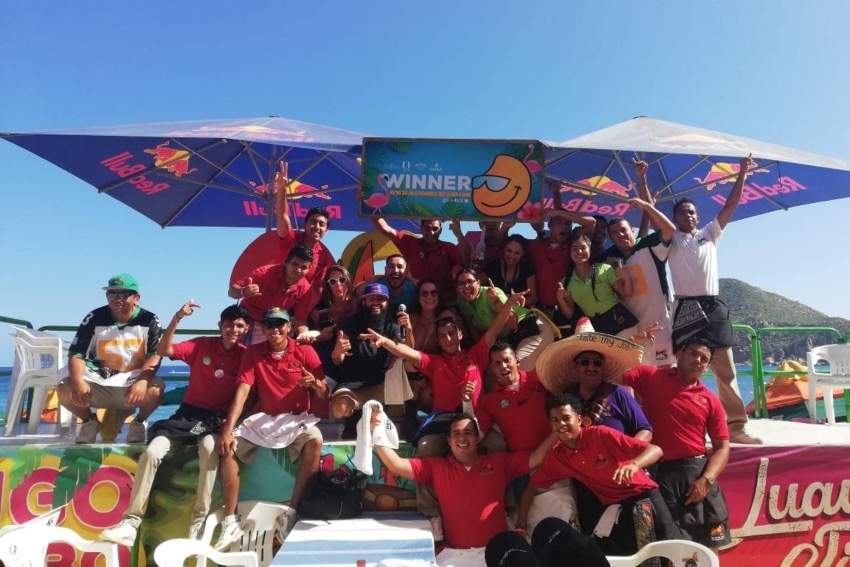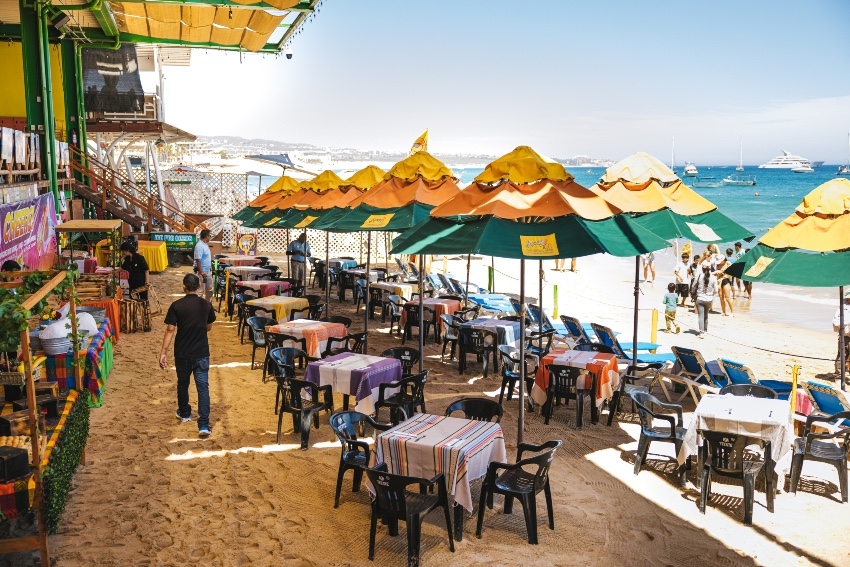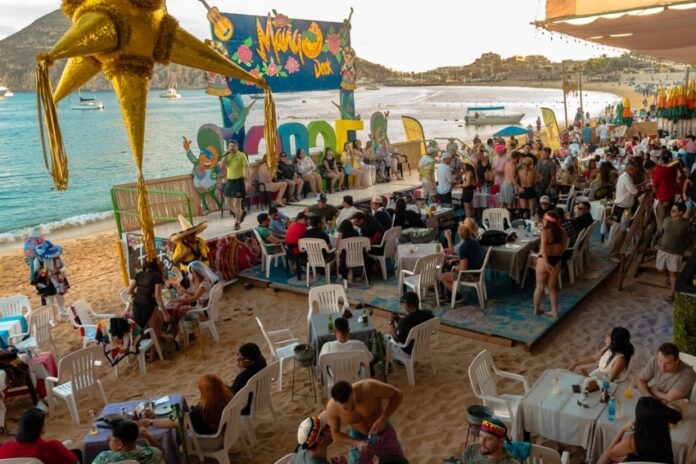Mango Deck is unquestionably one of the bars and restaurants most associated with Los Cabos tourism. Centrally located on Playa El Médano, the biggest and most popular beach in Cabo San Lucas, Mango Deck is enormously popular, albeit best-known as a “daylife” rather than a nightlife destination (it’s open daily from 8 a.m. to 11 p.m.).
However, despite its reputation for free-flowing drinks, particularly during Spring Break, Mango Deck has always been both a bar and a restaurant, offering some of the best food on the beach. Plus, it’s an activities center, meaning you can not only enjoy fresh seafood, ice-cold cervezas and cocktails here but also, for example, rent a waverunner or enjoy other water-based activities. It’s a sort of all-in-one vacation experience.

To delve deeper into the history and evolution of Mango Deck, I went to the most knowledgeable sources: owner Ricardo Araoz Gamiño and his son, Garrit Araoz Wilkes, who serves as general manager. Here’s what they had to say.
When was Mango Deck first opened? Whose idea was it?
Mango Deck opened in 1998. It was Ricardo’s idea, along with his friends Luis, Jesús, Gabriel, David and José.
Did the beachfront land come from an ejido, or was it via permission from [Profepa] or some other government agency?
The beachfront location was requested from Zofemat, which is the agency in charge of these areas. (Zofemat, or Zona Federal Marítimo Terrestre, manages Mexico’s coast up to 20 meters from the high tide line. It has exclusive access to grant licenses, permits and concessions within these areas.)
I remember, Garrit, you once told me about Médano Beach when you were a kid, and how there were different names for different parts of the beach. Can you provide our readers with some historical context on what Playa El Médano looked like before the opening of Mango Deck?
The area was always known as El Médano. The names of the beaches were more to identify where exactly you were. There was Hacienda Beach, formerly in front of the Parr family’s Hacienda Hotel — the first hotel in Cabo San Lucas, opened by Abelardo “Rod” Rodriguez in 1963 and subsequently sold to fellow Los Cabos hotel pioneer William Matt “Bud” Parr in 1977.
Rafa Beach was what we called the area in front of Rafa Sandoval’s house, which is now the access point between Hacienda [Beach Club and Residences] and Corazón [Cabo Resort and Spa]. There was also Brujita Beach, formerly located where Andromeda Divers is now; Planta or Empacadora Beach, the small bay in front of what remains of the old cannery, bordered by the old pier that [Hurricane] Odile [in 2014] demolished; and Sanai Beach, the beach on the other side of the pier.
Mango Deck has become incredibly popular for several reasons. One of them is as a destination for students on Spring Break. When did that Spring Break popularity begin to happen, along with the contests, shots from Big Johnson, and other fun activities?
The popularity with students began around 2003, when the Spring Break Cabo company approached us with an offer to bring them there, including a food and beverage package. In the beginning, there was no Big Johnson [a mustachioed, bandolier-wearing host who dispenses tequila shots], nor any host.
Much of our development has been through trial and error. The entertainment started with Batucas, a manager who brought a microphone to test the new equipment and began greeting people and telling jokes. Big Johnson was created by Carlos Peralta. The contests were started by Jonathan, Víctor and Raúl, some of the first MCs we had.
Speaking of activities, Mango Deck is a sort of a vacation all-in-one, in that it’s a bar, restaurant and an activities center. Was it always like that, or has it evolved over the decades?
It started as a restaurant-bar, with less than half of what it is now, a few tables under the roof, a few more on the beach and, at most, 20 lounge chairs on the beach. We had two activity rental locations nearby, and we thought, “Why not try it?” And that’s how, at the time, we ended up with Mango Deck waverunners.
How has the menu at the restaurant changed through the years, and how would you describe your food selection now?
We started with a fairly basic menu. It was mainly comfort options — burgers, chicken fingers, chicken wings and sandwiches. With the tastes of our customers, ideas from Cristina, our chef, and feedback from staff, we have grown, and today we have more regional flavors with a homestyle touch.
What’s the house specialty?
Our signature menu items are the sole sandwich, the Mango Deck roll, the molcajete and the Mango cowboy burger.
What percentage of people order food versus those who just come for drinks?
We could say it’s 40% on one side, 60% on the other. Most of our guests order something to eat with their drinks.
Do you have a signature cocktail, or are cubetas of ice-cold beer the staple?
Although Mango Deck is our signature drink, we take it upon ourselves to make buckets of beer famous. Our margarita is amazing too.
What kind of activities can people arrange at Mango Deck?
All of them! We have an activities team that is up-to-date on everything the destination has to offer for activities.

I remember after Category-4 Hurricane Odile in 2014 that Mango Deck, like many places locally, was very hard hit. What was that recovery like, and would you say it made the business stronger in the long run?
Like everyone else, the impact was very strong. It destroyed half of the restaurant, the entire deck area, like the entire town. We were without electricity for 15 days, with the advantage that we had a generator, but we could only use it occasionally due to the fuel shortage. All of us who worked there took shifts to clean the restaurant and keep everything clean. We had three shifts because some stayed overnight to work. We ate lunch and breakfast here. The team itself set a rule that no one, not even the managers, broke. If you arrived at lunchtime, you had to do something to sit at the table. That team of men, women — young and not-so-young — made Mango Deck much stronger than it already was. In 10 days, we had everything ready to reopen, but the permit arrived about 15–20 days later.
The popularity of Mango Deck is pretty staggering. You have over 100,000 followers on Facebook, for example. Why do you think people love Mango Deck so much, and why has it been so enduringly popular?
It’s always been a place where you can leave your stress and worries at the door, where everything is good, people know you, know your name and we’re always happy to have you back. Where you feel better than at home.
Any current promotions or special events coming up?
We have our Deckpechado night every two weeks and — already on the way — our New Year’s Eve party. As with the bucket of beers, we take responsibility for making theme parties come back strong.
Chris Sands is the Cabo San Lucas local expert for the USA Today travel website 10 Best, writer of Fodor’s Los Cabos travel guidebook and a contributor to numerous websites and publications, including Tasting Table, Marriott Bonvoy Traveler, Forbes Travel Guide, Porthole Cruise, Cabo Living and Mexico News Daily.
